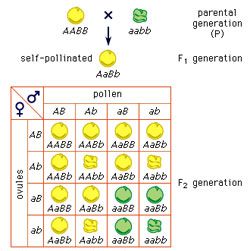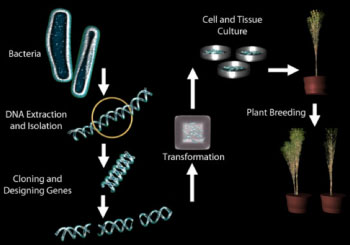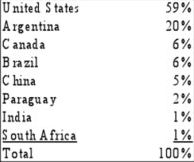The genetic manipulation of crops such as soybeans, maize, canola, and cotton has the potential to increase crop production and sustain our the world’s population. However, from the first theories of selective breeding and Gregor Mendel’s hereditary factors to contemporary practices of DNA splicing, the practice of genetic modification has been fraught with controversy. Selecting the most desirable genes in a plant species can lower the time and cost of food production, increase the nutritional value, and help prevent susceptibility to disease or spoiling, thereby helping to solve some of the world’s food shortage problems. However, there are setbacks to pursuing this technology. The widespread use of pesticides on genetically modified crops may bring an evolution of bacteria, weeds, and insects with greater pesticide resistance. Also, accidental transgenic splicing may result in food that are unintentionally allergenic or bring serious medical risks. For this reason, federal governments and consumers must decide to what degree and under what circumstances genetic manipulation should be performed.
Imagine a technology that could feed the 923 million people worldwide who suffer from hunger [1]. Imagine a way to prevent food from spoiling and significantly lower its production time and cost. Such technology already exists in genetic modification.
Crops are the main genetically modified (GM) product. Most harvests of the “big four” crops – soybeans, maize, canola, and cotton – in the United States are genetically modified. GM crops have numerous advantages, yet many countries strictly regulate their cultivation. The future of GM crops remains a vital debate, as its applications have several advantages and disadvantages to be considered.
Development of Genetically Modified Foods
The topic of genetic manipulation has been studied since the late 1800s, even before the discovery of the genetic material, DNA. Selective breeding was the first method of genetic manipulation. The immense technological advances of the 20th century allowed for a second method to emerge, the transgenic manipulation of a single gene. Today, both techniques are put to use to genetically modify crops.
The Concept of Heredity
In the late 19th century, Gregor Mendel conducted the first genetic modification research and discovered the basic principles of inheritance. Known as the “father of modern genetics,” Mendel cultivated different types of pea plants and studied their modes of reproduction by cross-breeding purebred specimens. He learned that each physical characteristic of the plant originates from two units of heredity, one from each parent. He named those hereditary units “factors”, now known as genes.
In one of his experiments, Mendel selectively bred yellow round pea plants with green wrinkled peas (see “parental generation” in Fig. 1). The first generation (F1) offspring had a set of characteristics from only one of the parents: yellow color and a round shell. Mendel identified those traits as dominant, and the green wrinkled traits as recessive. When he self-crossed the F1 generation, a range of new characteristics emerged in the second generation (F2) offspring. In addition to the yellow-round and green-wrinkled characteristics of the parents, the second generation contained yellow-wrinkled and green-round peas (see “F2 generation” in Fig. 1).
Mendel concluded that different factors such as color and roundness are inherited independently from one another, thus obtaining progeny with various combinations of traits. This simple selective breeding process was the first form of genetic modification. Since then, the science of genetics has undergone tremendous development. Today, a single gene can be manipulated to obtain a desirable characteristic.
Techniques of Genetic Manipulation
The basic principle of the GM technique is the transfer of genes from one organism to another in order to change its characteristics. Genes of essentially different organisms such as bacteria and plants can be hybridized to form a novel transgenic entity.
The first step of the transgenic process is the isolation of the bacteria’s entire DNA. The genomic sequence is then treated with a special enzyme that identifies the desired gene and cleaves it from the original DNA molecule. Next, the targeted gene is incorporated into a plasmid, a type of circular DNA molecule found in bacteria. The plasmid replicates independently, allowing it to propagate, creating many copies of the gene. Once the recombinant plasmid had been amplified, it is added to wounded leaf fragments on a growth media. A copy of the target gene is released from the plasmid and transferred to the plant cell, where it integrates into the plant’s DNA. The new plants grown from these cells contain the foreign bacterial gene (see Fig. 2 for GM technique steps). Once the cloned prototype is made, it can be commercially bred with great ease.
GM Foods Thus Far
In the 1970s, researchers first attempted to synthesize recombinant food products with the objective of improving crop protection [2]. More than 20 years passed until the first genetically engineered product, a tomato, was introduced to the U.S. market in 1994. In 1996, the first GM seeds were commercially cultivated. Today the United States harvests more than 50% of the global production of genetically modified foods including rice, maze, soybean, canola, and cottonseed [3].
The crops are customized to resist plant viruses, insects, and herbicides. For example, soybean plants are modified to resist glyphosate, a common herbicide, so that they can resist weed elimination treatments [4]. One treatment of glyphosate per season can eliminate weeds while leaving the desired soybeans intact, essentially utilizing the field’s soil in the most efficient way possible (see Fig. 3). In the United States, 92% of the grown soybean is altered to resist glyphosate [5].
The Advantages of Genetic Modification
As the global population continues to expand, food remains a scarce resource. Genetically engineered foods offer significant benefits by improving production yield, lowering transportation costs, and enhancing the nutritional content.
GM plants can be transformed to flourish in harsh conditions, such as cold weather, thus expanding the potential cultivation area. A group of Cornell University researchers have cloned an aluminum-tolerant gene in sorghum, a type of grain similar to wheat, to create a strain of sorghum that can grow in toxic aluminum-containing soil [6]. Magalhaes states that aluminum toxicity occurs in acidic soil, limiting crop production in approximately 50% of the world’s arable land. The research and development of genetically-engineered, aluminum-tolerant sorghum could help third world countries improve crop yields and grow crops in environments where current crops cannot be harvested. Genetic modifications can also produce seeds that are more insect resistant and herbicide tolerant, which allows for maximal utilization of limited soil. Monsanto, the leading GM brand in the United States, claims that the average production cost of soybeans per acre is reduced by 16% with the use of their seeds [7]. Even though the cost of GM seeds is higher than regular plant seeds, the higher production yield on the same area of land reduces the overall cost [8].
Another important advantage of GM food is its enhanced ability to withstand long-distance transportation. The GM crops are picked when still green and allowed to ripen during transportation, therefore yielding a longer shelf life. Even with prolonged shipping and storing periods, the product reaches its destination without spoiling. In addition, the GM crops are modified to survive the potential damages of excessive handling and transportation so they appear fresh and ripe when they reach the consumer.
Developing countries remain highly dependent on basic grains as their primary food source. This diet can lack important nutrients and can result in malnutrition, especially for more impoverished populations. A great deal of current research seeks to modify these basic crops to contain essential vitamins and hence alleviate the nutritional deficiency. Several different GM crops for malnutrition are expected to be released for cultivation in the next 5-10 years [9].
Furthermore, plants can be modified to lack potentially lethal allergens that are naturally occurring in the original plant. For example, 1.1% of the U.S. population or (~3.3 million people as of July 2007 estimate) are allergic to peanuts and tree nuts, a serious condition considering that peanuts and tree nuts are used in the same processors that produce many of our packaged foods [10]. By eliminating the allergenic gene from nuts, the frequency of allergic reactions to these products can be significantly lowered.
Potential Threats
Despite the numerous advantages, GM foods can potentially become a major threat to the environment as well as to human health. Most GM crops are designed to resist herbicides and pesticides while fields are treated to eliminate weeds and insects. With time, farmers’ liberal use of stronger pesticides naturally selects for weeds and herbivores that are pesticide resistant, just as some bacteria become resistant to antibiotics because of their extensive use in conventional medicine. As a result, generations of transgenic weeds and insects which cannot be controlled by common herbicides and pesticides would evolve. New, more toxic treatments will need to be synthesized every time the target pest becomes resistant to the current herbicides and pesticides. Furthermore, GM crops contain antibiotic resistant genes that can be transferred to the harmful microorganisms living in the human body. In such cases, those microorganisms can become immune to the common antibiotic treatments and become untreatable.
Another hazard is the potential of GM foods to be allergenic, thus evoking life-threatening immunologic reactions in some individuals upon consumption. The main strategy used thus far on recombinant foods “is to avoid transferring genes or genetic material that code for known allergens […] and to screen products of unregulated genes to determine if they code for proteins with allergenic potential” [10]. However, not all allergenic genes are known, nor are all the allergenic reaction mechanisms understood. Thus, new allergenic foods could unintentionally be created since there is not enough accumulated knowledge to achieve complete control of the recombinant products.
An even greater threat surfaces because new transgenic foods could not only be allergenic but also unintentionally toxic. The arbitrary incorporation of foreign genes into the DNA can lead to fundamental changes in the biochemical structure of the organism. Such radical changes can potentially have a toxic nature.
The Regulatory Environment
Since its initial development, the use of genetically modified food has been the subject of extensive global debate and controversy. Despite its significant benefits, public concern about its long-term health and environmental effects led many governments to establish mandatory labeling, traceability and prohibition regulations. However, governmental regulations on GM crop cultivation in the European Union (EU), the United States, and Africa vary greatly (see Fig. 4 for global crop production percentages).
Generally, consumers in the European Union (EU), especially in France and Germany, are the most apprehensive about the production of genetically modified foods. EU governments require all GM food and ingredients be clearly labeled and contain a DNA sequence that identifies its origin for traceability. Traceability allows the product to be quickly identified and pulled out of the food chain in the event of a future problem. Furthermore, the EU has strict regulations on the importing, exporting and new development of these products.
In contrast, the U.S. federal government has a less stringent policy regarding GM food regulation despite the fact that the U.S. cultivates the majority of the world’s GM crop [11]. Although GM food regulation falls under the oversight of the Food and Drug Administration (FDA), the United States Department of Agriculture (USDA) and the Environmental Protection Agency (EPA), the federal government considers GM foods generally safe and does not require pre-market testing or labeling. Nevertheless, many states and local governments have taken steps to protect consumers and the environment from the potential hazards of GM foods. States like California, Vermont, Massachusetts, and Arkansas have enacted statewide and local regulations to establish GM-free regions or to regulate production, testing, and labeling.
Surprisingly, despite many recent humanitarian crises in Africa, many countries such as Algeria, Benin, Ghana, Mozambique, Nigeria, and Sudan declared themselves GM-free zones and refused to accept GM food as food aid due to environmental concerns and food safety fears. Intense pressure from USAID (United State Agency for International Development) and other world humanitarian organizations resulted in a compromise where milled products would only be distributed in some countries, thus avoiding a larger environmental impact.
The Future
Although genetically modified crops offer a potential solution to food shortages around the globe, the viability of their cultivation remains questionable. The enhanced production of GM crops to eliminate hunger carries hidden costs in environment and health concerns. This issue continues to be controversial and the future of genetically modified crops remains uncertain.







